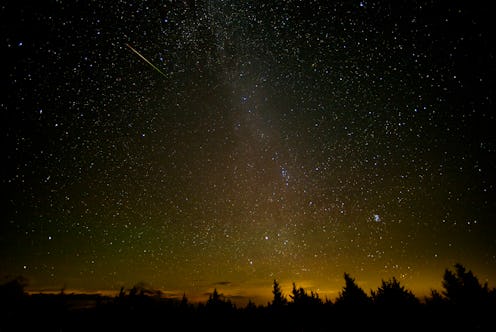Life
This Weird Asteroid Might Actually Be An Alien Spacecraft, According To These Scientists

On Dec. 14, NASA plans to announce "major" alien news, but Stephen Hawking's Breakthrough Listen team may have just stolen some of NASA's thunder. A new press release suggests the 'Oumuamua asteroid may in fact be an alien spacecraft. During the interstellar rock's flyby in November, scientists only had a brief time to study it, but Breakthrough Listen is now planning an in-depth observation of 'Oumuamua to take place on Dec. 13, and the results, whether they confirm alien life is onboard or not, are likely to be worthy of a season or two of The X-Files.
'Oumuamua was first seen in October 2017 by the Pan-STARRS project at the University of Hawaii, but we didn't know what it looked like until Nov. 20, when NASA described it as a "rocky, cigar-shaped object with a reddish hue." Astronomers weren't sure where it came from and weren't entirely sure what it was, but they dubbed it the first official interstellar object to reach our solar system and kept note of its progress as it traveled past Earth. ('Oumuamua, it must be noted, means "messenger sent from the distant past to reach out to us.") However, they also kept note of some of 'Oumuamua's... shall we say, oddities.
First, 'Oumuamua travels at a hugely high speed — scientists clocked it at 196,000 miles per hour — which "suggests it is not gravitationally bound to the Sun," according to the press release from Breakthrough Initiatives. Weird. But even weirder is 'Oumuamua's shape. Cigar-shaped, as NASA pointed out, and "hundreds of meters in length but with width and height perhaps only one tenth as long," Breakthrough Initiatives added. NASA previously estimated it was about a quarter-mile long.
In a press release from the European Southern Observatory, scientists got a little more specific about color and form, noting that 'Oumuamua is likely dark red because of the radiation in space, and that it's unusually massive for an object hurtling through space. Plus, it has an unusually "complex, convoluted shape."
Not only is this cigar-like or needle-like shape a generally odd one for nature to produce, it's the shape long thought the most plausible for allowing interstellar travel, "since this would minimize friction and damage from interstellar gas and dust," Breakthrough Initiatives wrote. The organization does note that despite all the hubbub, a natural origin for 'Oumuamua is statistically more likely. But no one can come to an agreement on just what that origin might be.
When ‘Oumuamua passed by Earth, it did so at about 85 times the distance from us to the Moon, which is a "stone's throw," according to Breakthrough Initiatives. That may sound odd, but not when you compare that distance to how far apart we are currently: More than twice the distance between Earth and the Sun. Despite that, Breakthrough Listen will still be able to closely observe ‘Oumuamua, and plans to do so Dec. 13, at 3 p.m. ET.
"Using the Robert C. Byrd Green Bank Telescope, [Breakthrough Listen] will continue to observe ‘Oumuamua across four radio bands, from 1 to 12 GHz," Breakthrough Initiatives said in its press release. "Its first phase of observations will last a total of 10 hours, divided into four 'epochs' based on the object’s period of rotation."
Even if 'Oumuamua doesn't turn out to be an alien spacecraft, observing it will be a boon to our space exploration capabilities. "[This] affords Breakthrough Listen an opportunity to reach unprecedented sensitivities to possible artificial transmitters and demonstrate our ability to track nearby, fast-moving objects," team member Andrew Siemion, Director of Berkeley SETI Research Center, said in the press release. "Whether this object turns out to be artificial or natural, it’s a great target for Listen."
That's all wonderful, and anything Breakthrough Listen discovers will certainly benefit humanity. But it's hard not to hope observations of 'Oumuamua will be what finally confirms that intelligent life exists out there among the stars, and that we are not alone.